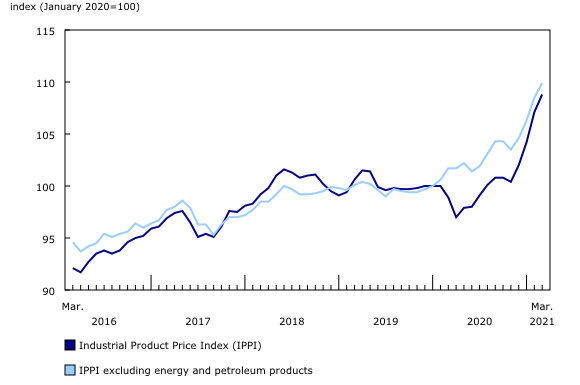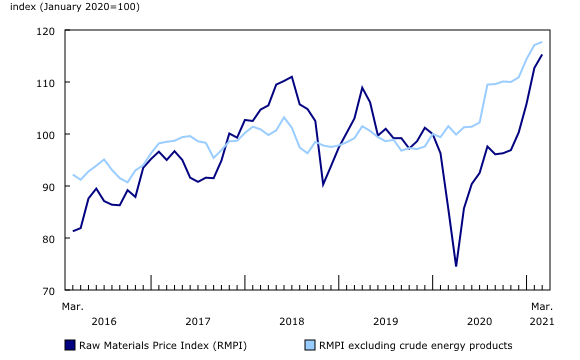Industrial product and raw materials price indexes, March 2021
Archived Content
Information identified as archived is provided for reference, research or recordkeeping purposes. It is not subject to the Government of Canada Web Standards and has not been altered or updated since it was archived. Please "contact us" to request a format other than those available.
Released: 2021-04-30
In March, the Industrial Product Price Index (IPPI) increased 1.6% month over month and 10.0% year over year. The Raw Materials Price Index (RMPI) was up 2.3% month over month and up 34.7% year over year.
Industrial Product Price Index
In March, the IPPI rose 1.6%, its fourth consecutive monthly increase. The IPPI excluding energy and petroleum products was up 1.3%. Among the 21 major commodity groups, 14 were up, 6 were down, and 1 was unchanged.
Among the major commodity groups, the lumber and other wood products category contributed the most to the gain in the IPPI, up 10.2% from February and up 68.2% from March 2020. Softwood lumber (+11.9%), veneer and plywood (+20.1%), and reconstituted wood products (which include medium-density fibreboard [MDF]) (+11.6%) all increased. The price of Canadian lumber is influenced significantly by housing demand in the United States, where, seasonally adjusted residential housing starts rose 19.4% in March compared with February. In Canada, seasonally adjusted housing starts were up 21.6% in March.
The energy and petroleum products group (+4.6%) was the second largest contributor to the upward movement in the IPPI. The increase was mostly due to higher prices for motor gasoline (including blending components and ethanol) (+6.8%) and diesel and biodiesel fuels (+3.5%). These price increases were mainly attributable to higher prices for crude oil.
Chemicals and chemical products were up 4.1%, mostly because of increases for petrochemicals (+14.1%), plastic resins (+9.9%) and ammonia and chemical fertilizers (+6.6%). Extreme weather in the southern US petrochemical region in February continued to affect the supply chain, reducing supply and driving up downstream product prices. The price of fertilizers is also being affected by high crop prices, which incentivize increased production and consequently necessitate more fertilizer.
Fruit, vegetables, feed and other food products rose 1.7%, mostly as a result of increases in prices for grain and oilseed products not elsewhere classified (which include canola oil) (+5.9%), and margarine and cooking oils (+4.8%).
Primary non-ferrous metal products declined 1.3%, mostly because of a decrease in the price of unwrought gold, silver, and platinum group metals, and their alloys (-6.0%). Rising bond yields in the United States may have influenced the decline in gold and silver prices.
Year over year, the IPPI was up 10.0%, the largest increase since January 1995 (+10.4%). Excluding energy and petroleum products, the IPPI rose 8.1%. The year-over-year change in the IPPI was driven mostly by higher prices for lumber and other wood products (+68.2%), energy and petroleum products (+32.4%), and primary non-ferrous metal products (+29.3%).
Raw Materials Price Index
The RMPI was up 2.3% in March, its sixth consecutive increase. Excluding crude energy products, the RMPI was up 0.5%. Among the six major commodity groups, five were up and one was down.
Crude oil and bitumen rose 7.0%, while natural gas fell 11.1%, following a 12.4% spike in February. Crude oil prices were driven up by continued restriction of production by OPEC+ countries (countries from the Organization of the Petroleum Exporting Countries Plus). Concerns about COVID-19 and vaccine rollouts, as well as the blockage of the Suez Canal, also contributed to the volatility of oil prices in March.
Metal ores, concentrates and scrap declined 2.3% in March. This was driven by a marked drop in prices for precious metals, including gold and silver.
Crop products rose 4.0%, mostly as a result of a 9.7% gain in canola prices, which recorded their thirteenth consecutive monthly increase. Notably, canola was up 74.4% on a year-over-year basis. Factors influencing the price include supply, which has been limited by a lower-than-expected yield in 2020, as well as strong global demand.
Prices for animals and animal products were up 2.3%, mostly because of higher prices for hogs (+10.6%)
Year over year, the RMPI rose 34.7%, the largest gain on record since the start of the series in January 1981. Excluding crude energy products, the RMPI was up 16.0%. The year-over-year change was mostly due to higher prices for crude energy products (+91.7%). Metal ores, concentrates and scrap (+19.7%), and crop products (+31.5%) also contributed to the change.
Note to readers
The Industrial Product Price Index (IPPI) and the Raw Materials Price Index (RMPI) are available at the Canada level only. Selected commodity groups within the IPPI are also available by region.
With each release, data for the previous six months may have been revised. The indexes are not seasonally adjusted.
The Industrial Product Price Index reflects the prices that producers in Canada receive as goods leave the plant gate. The IPPI does not reflect what the consumer pays. Unlike the Consumer Price Index, the IPPI excludes indirect taxes and all costs that occur between the time a good leaves the plant and the time the final user takes possession of the good. This includes transportation, wholesale and retail costs.
Canadian producers export many goods. They often indicate their prices in foreign currencies, especially in US dollars, and these prices are then converted into Canadian dollars. In particular, this is the case for motor vehicles, pulp and paper products, and wood products. Therefore, fluctuations in the value of the Canadian dollar against its US counterpart affect the IPPI. However, the conversion to Canadian dollars reflects only how respondents provide their prices. This is not a measure that takes into account the full effect of exchange rates.
The conversion of prices received in US dollars is based on the average monthly exchange rate established by the Bank of Canada and available in Table 33-10-0163-01 (series v111666275). Monthly and annual variations in the exchange rate, as described in the release, are calculated according to the indirect quotation of the exchange rate (for example, CAN$1 = US$X).
The Raw Materials Price Index reflects the prices paid by Canadian manufacturers for key raw materials. Many of those prices are set on the world market. However, as few prices are denominated in foreign currencies, their conversion into Canadian dollars has only a minor effect on the calculation of the RMPI.
Basket update and methodology changes
Starting with the October 2020 reference period, the IPPI and RMPI have been using an updated basket and methodology. The indexes have been converted from 2010 = 100 to January 2020 = 100 and also updated to use a weighting pattern based on the 2016 production values of Canadian manufacturers.
At the same time, the IPPI and RMPI have been modernized with the adoption of a weighted geometric (Jevons) formula and incorporation of parental imputation as the default imputation methodology for missing price quotes.
The IPPI and RMPI are now using the North American Product Classification System (NAPCS) Canada 2017 version 2.0 and the North American Industry Classification System (NAICS) Canada 2017 version 3.0.
Products
Statistics Canada launched the Producer price indexes portal as part of a suite of portals for prices and price indexes. This web page provides Canadians with a single point of access to a variety of statistics and measures related to producer prices.
The video Producer Price Indexes is available on the Statistics Canada Training Institute web page. It provides an introduction to Statistics Canada's producer price indexes—what they are, how they are made, and what they are used for.
Next release
The industrial product and raw materials price indexes for April will be released on May 31.
Contact information
For more information, or to enquire about the concepts, methods, or data quality of this release, contact us (toll-free 1-800-263-1136; 514-283-8300; STATCAN.infostats-infostats.STATCAN@canada.ca) or Media Relations (613-951-4636; STATCAN.mediahotline-ligneinfomedias.STATCAN@canada.ca).
- Date modified:




